Editor's Note
Dear Readers,
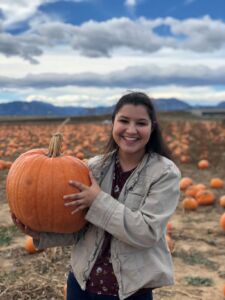 With the impact of COVID-19 on our ability to interact with one another in-person comes greater attention to and awareness of the environment– the ways the environment helps us, the impact we have on it and how this relationship may change in the future.
With the impact of COVID-19 on our ability to interact with one another in-person comes greater attention to and awareness of the environment– the ways the environment helps us, the impact we have on it and how this relationship may change in the future.
Our third magazine issue, “The World Around Us,” highlights the ways in which our environment shapes us, just as we shape it. With a range of stories and photo essays focusing on a variety of topics including the impact of move-in and COVID-19 on the Boulder area, how hiking can provide solace, a how-to-camp guide and a narrative piece on the journey to becoming “outdoorsy,” each story speaks to the different relationships we have with nature.
In light of the last magazine edition that focused on mental health, many recommend venturing outdoors. Research has found that spending time outside can help reduce anxiety, and given the ways that COVID-19 has caused us to often be inside and on our devices, going outside can be a helpful way to take care of ourselves.
As always, I want to thank the writers for this magazine issue for all of their hard work. We are currently working on developing more themes and story ideas for upcoming magazine issues. If you have any ideas, suggestions or would like to be a part of a future magazine issue, please contact me at tayler.shaw@colorado.edu or you can contact The Bold at thebold@colorado.edu.
I hope you all are safe and well!
Cheers,
Tayler Shaw
Magazine Editor-in-Chief
Hiking Through Tribulations
By: Sierra George
College is challenging for everyone. You have to find something that helps you step back from your life and reassures you that you can accomplish anything life throws at you. For me, that was hiking, but everyone is different. It is easy to feel your whole world is college, but it is not. Take the time to leave campus and figure out what works best for you.
Enchanted Mesa Trail
Two days after moving into Buckingham Hall in 2019, my dorm did a group hiking trip to Chautauqua. My roommate and I decided to go and meet some people in our dorm. I was scared that people wouldn’t like me. I came in wanting a fresh start, so I forced myself to start talking to everyone by me on the hike. By the time we reached the top, I had already made so many friends, and we made plans to get lunch when we got back to campus. It was hard putting myself out there, but if I never did, then I would have never met some of the friends I still have to this day.
Bear Lake
Right before I left for Thanksgiving break, myself and two friends, Syd and Brooke, took a trip to Bear Lake in Rocky Mountain National Park. I needed to clear my head for a bit. During this part of the semester, professors were just piling assignment on top of assignment; I had a test everyday. I thought I was going to fail out of college. As we began the hike, we realized we were hiking in a foot of snow in below freezing temperatures. We had not prepared for this kind of hike. We all wanted to turn around, but we drove an hour an a half to see the lake. We trekked onwards. As the trees broke away, we could see the sun perfectly hitting the mountains and the icy lake. As we reached the open space, all the troubles to get to that point were worth it. The view felt unreal. It took our breaths away. At that moment, I knew I had to just push through all those assignments and tests; because once it was Thanksgiving break, it was going to feel so good knowing I accomplished all of it.
Royal Arch Trail
Second semester rolled around and I was excited, at first. Something ended up happening in my life that caused tension between me and my family, and it started to affect my school work. It felt like my own life was leaving me behind. Everything was at high speed and I couldn’t slow it down. I knew I needed to clear my head and the best way to do so is to go on a hike. We decided to do the Royal Arch hike in Chautauqua. The hike was not easy. It was over an hour of uphill. I was out of breath and tired, but I pushed until I reached the top. When I finally got to the top, I saw this rock structure that didn’t seem real. As I looked out onto the front range, I knew my problems were small compared to the whole world. My life seemed like a mess, but it was manageable. Sitting on rock made me put my life into perspective and be grateful for the things I have and things I can control.
My Hiking Tips:
Stay on designated trails
Bring plenty of water
Know the area you are hiking
Bring sunscreen (Colorado is closer to the sun)
Don’t take anything off the trail
Being Sustainable: Addressing Waste in Boulder
By: Grace Naber
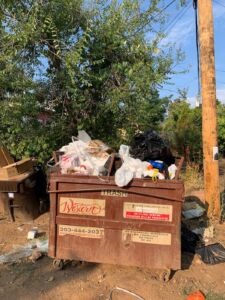
The University of Colorado Boulder often boasts about its efforts to create a more sustainable campus and community. However, throughout the move-in process in August 2020, I noticed there were dressers and couches spewed throughout the streets on the Hill and trash cans that overflowed with waste. It made me wonder: for a campus that is in such an environmentally conscious place, why is this not reflected in the values of CU Boulder students? I could not wrap my head around why there is so much waste around campus and on the Hill.
“In terms of Boulder as a town, I think it is an extremely environmentally conscious place, especially coming from Chicago,” says Alexander Kahn, a friend of mine and a junior at CU Boulder. “However, I don’t see that reflected with college students. I think us students have the knowledge about what we should do, but that is impacted by a lack of responsibility and general care, which results in the trash issues we see on the Hill.”
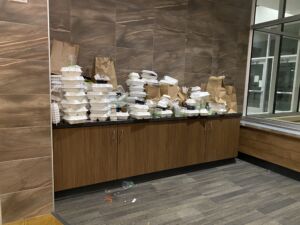
Issues with high levels of waste, however, do not only concern the Hill. Throughout the beginning of the semester, toppling piles of food containers in trash and compost bins could be seen on-campus, sometimes reaching heights that would cause the containers to spill onto the floor.
The increase is in part due to the dining halls transitioning to only offering to-go meals for food. CU Housing and Dining Services offers compostable and recyclable containers for the grab-and-go dining to cut down on waste; however, as the compost bins around dining halls were quickly filled, the remaining compost containers would often be disposed of in the recycling or landfill bins.
In order to address this, “CU has added 20 carts and four dumpsters for collection of compost, and a dozen more receptacles in the vicinity of C4C, Farrand and the Village Center have been converted to compost bins,” says Joshua Lindenstein, the assistant director and spokesperson of strategic relations and communications for CU Boulder.
When it comes to off-campus waste, “the E-Center also coordinates yearly with Off-Campus Housing and The Neighborhood Relations office around move-out to provide donation info,” says Lindenstein.
However, even with the donation information that the CU Boulder Environmental Center, also called the E-Center, offers, there are still issues with high levels of waste. While some students like Kahn think this is due to a lack of concern by students, other Boulder community members, like my mom, Jeanne Naber, think there may be a need for more education on the topic of sustainability.
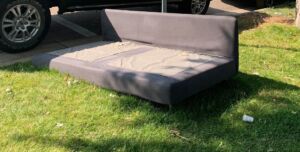
“It’s pretty obvious when driving around the Hill which students are educated about recycling and waste, and which are not,” says Naber. “It is discouraging to see broken bottles, cans and broken furniture littering neighborhoods on the Hill.”
In an effort to help educate students about how they can be more environmentally conscious, the students and faculty involved in the E-Center offer resources and information on how to live a more sustainable life, such as through the EcoKits program.
EcoKits are part of an initiative by the E-Center to help students living both on-campus and off-campus reduce their environmental impact and improve their sustainability habits. The kits include items such as two LED light bulbs, bike lights and a reusable utensil kit. For students who live off-campus, their kit will also include items such as a recycling bin, a compost bin and toilet tabs for detecting leaks. The kits are dropped off at the doorstep of the student through a contact-less delivery.
When students sign up for a free EcoKit, they will also schedule a virtual “Eco Visit” that consists of talking with an EcoBuffs student expert about how to be more environmentally conscious; according to the E-Center website, topics may include how to reduce your energy bill, live a more zero waste lifestyle and improve the air quality in your home.
While efforts like this represent an opportunity for students to become more environmentally conscious, there is still work to be done– work that is especially important to Boulder community members like Naber.
“Since Boulder is such an environmentally progressive place, I think it is disheartening to the people who live in Boulder when streets are trashed by college students,” says Naber. “I really wish CU students cared more about doing the right thing for the environment and recognized the impacts their choices have on the Boulder community.”
For more information on how you can make a positive impact on the environment, check out https://www.colorado.edu/living/sustainability.
The Environmental Impact of COVID-19
By: Kevin Wu
Since the COVID-19 pandemic began, the lack of human activity worldwide, dubbed “anthropause,” is believed to have caused a precipitous drop in air pollution. Highly populated cities such as Beijing saw clearer skies and wildlife populations began to rebound in areas around the world such as Yellowstone. With people staying home, animals could be spotted in places where they’ve once avoided. However, COVID-19 has had its negative effects as well. Since this disruption, it has provided cover for illegal deforestation operations in the Amazon rainforest, as well as caused a surge in bushmeat poaching in Africa.
University of Colorado Boulder
A little closer to home, COVID-19 has impacted not just how we interact with one another but also with how we interact with the environment. With the decision to switch to to-go dining on-campus, many students have spent their time outside eating with friends. However, issues arose when campus wide, to-go containers could be seen stacked high on or near bins, regardless of its compost, recycle or trash designation. Gradually over the weeks, the Environmental Center at CU Boulder began rolling out more compost bins in the vicinity of dining halls to help alleviate the issue.
Boulder County Open Space and Mountain Parks
Chautauqua Trailhead has remained quite the popular destination in Boulder for many decades and the COVID-19 pandemic has only made that more true. With the abrupt switch to remote learning and working, many have sought out the comforts of nature in order to get out of the house. Rules have now made it so that face masks are required upon visiting Boulder’s open space trails and parks. They can be taken off when you are with others who you have regular close contact with (such as roommates, families, etc.); however they must be worn when six feet of social distancing from others is not possible.
Rocky Mountain National Park
As the third most popular national park in the United States, Rocky Mountain National Park saw a record number of over 4.6 million visitors in 2019. However, the pandemic changed all that and the park temporarily shut down at the urging of local communities for approximately 67 days. It wasn’t until May 27, 2020, that Rocky Mountain National Park reopened and then soon started requiring visitors to create a reservation. The introduction of this timed entry permit system over the course of the summer capped the park’s capacity at 60% in order to reduce crowding. However, as of October 13, 2020, the requirement for timed permits will be waived for the time being.
The world and our local communities have undoubtedly changed. Potentially for the better, and maybe even for the worse as well. The environment is precious and if this pandemic has taught us anything, it is that this is a resource we sorely need– not just for recreation but for what it provides us.
"Why did you choose CU?": My Journey to Becoming “Outdoorsy”
By: Georgia Worrell
Click here to listen to Georgia narrate her story:
Upon my arrival to the University of Colorado Boulder in Fall 2018, one of the first questions I remember someone asking me was, “So, why did you choose CU?” As a campus composed of mostly out-of-state students, this question was consistently a conversation starter between freshmen in the dorms, as we were all meeting, mingling and trying to find our people. Although I am now a junior, I still find myself faced with this question now and again and my reaction remains the same as it did two years ago—I stall for a second, wrack my brain for something of substance to say and then blurt out, “Because why not?!”
In my experience, there seems to be a right answer to this question when posed among out-of-state students. If you say something about loving outdoor activities and how Boulder is the best place to do them, no one will look at you funny. The root of my anxiety around this question is the foreboding feeling that, in contrast to others’, my response does not include any reference to the outdoors, thus making me feel like I am falling short.
To make matters worse, I do not have the excuse of being from a city or urban setting where I would have never been exposed to the outdoors. I am from a small town in northern Idaho surrounded by woods and lakes and mountains to climb. However, unlike my peers both at home and in Boulder, I have never felt called to explore these areas. In fact, they kind of terrify me.
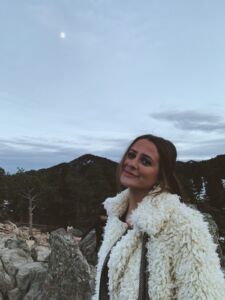
Just this summer, I found myself in a relationship with a man with whom I have very little in common. While he packs up his car every weekend to go explore the most remote corners of the Pacific Northwest, I send out a group chat to the girls to make plans for a wine night. Nevertheless, all relationships require some level of compromise and sacrifice, and to prove my fondness for this man, I agreed to endure 24 hours in his beloved domain. What occurred shortly after was the opposite of romantic. As the car sped along a bumpy logging road, I felt my heart sinking into my stomach and my hands shaking. By the time we finally arrived at the camping spot, the ridge of a secluded mountain, I was having a full-blown panic attack. I felt fearful of this unfamiliar environment—we were the only people within miles, which was obvious by the absolute silence; you could hear a pin drop. Also, we were parked on a steep ridge of the mountain. What if I fell off of the side, or worse, he did? It took me a long time to calm down, but even then, I was not good company; I was an anxious mess. It was not until we returned home the next day that my uneasiness lifted completely. Needless to say, what should have been a wholesome bonding experience for the two of us ended up being utterly petrifying. For me, it was the threat of an unknown world; for him, it was my reaction to the situation.
Throughout my life, others have tried to help me reconfigure my panicky notion of the outdoors—whether it be my dad trying to teach me how to set up a tent in our living room or friends extending invites to weekend-long camping trips. Although I appreciate these gestures, I think that my journey to being outdoorsy must include being strategic about my outdoor activities, so as to not repeat the unfortunate camping incident this summer. I do, in fact, want to see what other people see in nature; I want to feel the calmness and serenity that the outdoors provides to so many. Especially in Boulder, I feel that there are endless opportunities to pursue that feeling. That being said, as ridiculous as it may sound, I have created a checklist of outdoor activities that I want to complete, ranging in order from what I find to be least threatening, to activities that will push me outside of my comfort zone.
- [checklist-box title=”My Outdoor Activity Checklist” extraTitle=”” extraUrl=””]
- Visit Lost Gulch Lookout
- Walk around Chautauqua Park
- Ski Arapahoe Basin
- Rock climbing at CU Rec Center
- Visit Arches National Park and hike
- Snowshoe Dream Lake in Estes Park
- Climb a 14er
- Backpacking trip to Maroon Bells
- Weekend-long camping trip
- Summit Mount Everest
[/checklist-box]
(Big shout out to my friend Sarah for helping me curate this list and explaining to me what a 14er is! Apparently, a 14er is a mountain peak with an elevation of 14,000 feet.)
Checklist aside, I am always down for a picnic along Boulder Creek or a quick trip to Lost Gulch Lookout to take cute pics. I firmly believe that there is a place for everyone in the outdoors, and that it is okay that I am still trying to find mine. From now on, when people ask, “Why did you choose CU?” I will respond, “It is the perfect place for my journey to becoming outdoorsy.”
How-to Guide for Camping-Rookies in the Rockies
By: Marc-André Lacrampe
I recently graduated from CU in May 2020 with a bachelor’s degree in environmental studies. I grew up in Colorado with a heavy outdoor influence, often going skiing and camping most weekends, that eventually developed into an adulthood passion. I also worked at a summer camp in Colorado for four summers which was an invaluable learning experience when it came to outdoor education. All this to say, I love camping and the outdoors, but I also love teaching others how to best experience the outdoors in Colorado. This article is meant to be an informative guide to camping in Colorado for those who want to get into it. Becoming closer to nature is a beautiful human experience that we are lucky enough to be able to capture in our backyard, and I hope this helps the people reading this to do it!
ALTITUDE SICKNESS DISCLAIMER: If you are coming from a place located at sea level, it is important to know that if you are camping in the mountains at elevation for the first time, you can become dehydrated very easily, so you must be constantly drinking water. If you are consuming alcohol at elevation, it is common to become drunk more quickly than you would at sea level. Be responsible out there!
What to bring/do on a camping trip: Equipment and essentials
Before you can pack for a camping trip, it is an absolute must to check the weather forecast in the area you’re going camping. Even though it says it’ll be sunny in Boulder for the weekend, the weather could be totally different just an hour away.
Colorado campsites tend to be at elevations higher than 7,000 feet and in the mountains, which means the weather and temperatures can be extremely variable. You want to make sure your tent has a rain fly and stakes because even though it seems rare for Colorado to have a harsh rainstorm (let alone a rain that lasts longer than an hour), it can still happen.
Mountain climates are known for how cold they get at night. I would recommend at least a 20-degree bag if you’re going camping for a weekend during the summer months. If you plan on doing any winter camping, you’ll need one rated for 0-degree Fahrenheit and below.
CU offers camping equipment rentals through the Rec Center.
Unless you want to sleep on the cold, hard ground, a sleeping pad is a must-bring on a camping trip. There are several types of sleeping pads out there– foam, inflatable, rubber. Personally, I recommend an inflatable pad because they’re easier to store/carry and usually more comfortable than a foam or rubber mat.
The food situation will be different for everyone, but a good rule of thumb if you don’t have a camping grill is to bring food that is easily cooked over a fire (i.e. sausages, corn, cans of soup, etc.) or food that requires no cooking at all (i.e. sandwiches, Pop-Tarts, fruits and veggies, etc.). Also, plan meals with your friends to save space and money. The hardest part about bringing food is the amount of space a cooler takes up, so make sure to plan for that as well.
The number one piece of advice I can give when packing clothes is to pack light. You don’t need nearly as much stuff as you initially think you do. That being said, this checklist is what I think the average camping enthusiast needs to pack in their overnight bag for a weekend trip.
- [checklist-box title=”” extraTitle=”” extraUrl=””]
- Two light t-shirts
- One sweater, hoodie, fleece, etc.
- One rain jacket
- One pair of hiking boots
- One pair of comfy shoes for the campsite
- One to two pairs of shorts
- One pair of sweatpants/ leggings
- Three to four pairs of underwear (you never know)
- Two to three pairs of socks
- Toiletries, i.e. toothbrush/ paste, deodorant, menstrual products, Ibuprofen, etc.
- Sunscreen
- Headlamp/ flashlight (optional)
- Hammock (optional)
- Camping pillow (optional)
- Grill or stove (optional)
- A fun attitude
[/checklist-box]
Leave No Trace Principles:
The best way to keep enjoying the beautiful outdoor experience that Colorado has to offer is to treat it with respect, so it remains available for others in the future. These principles serve as a tool for recreationalists to use to avoid disturbing the delicate wilderness with their presence.
- PLAN AHEAD AND PREPARE: A successful trip is totally dependent on how well planned it is. Planning a trip helps ensure an enjoyable and safe experience for a group or an individual. This means knowing the weather in the area you’re going, bringing the right clothing and equipment and looking at a map before you go so you know where the nearest town or hiking trail is.
- TRAVEL AND CAMP ON DURABLE SURFACES: If you decide to go on a hiking or backpacking trip, make sure to go on an established trail that receives regular maintenance. This is to ensure that the beautiful landscape remains untouched and available to the wildlife that inhabit it. Durable surfaces that are the best for trampling include rocks, sand, gravel, snow, dry grasses and established campsites. If you are in a remote area that sees little use, be sure to minimize your impact even more.
- DISPOSE OF WASTE PROPERLY: This principle is becoming increasingly important in a world being consumed by single-use trash. For people who haven’t been camping in places with strict waste policies, it can be surprising to hear the extent to which you need to take care of your waste. If your campsite doesn’t have a latrine nearby, the best way to dispose of feces/wiping material would be to dig a hole and bury everything at a safe distance from water sources and your campsite. This method ensures sanitation of your temporary living space as well as keeps curious wildlife from coming into the camp to examine what you ate for lunch that day. Food waste should also be kept to a minimum and at a safe distance from where you’re sleeping in case bears are in the area. Everything that you don’t consume should be carried out of the campsite and taken to an established trash bin. This keeps the wilderness clean and beautiful for the next group.
- LEAVE WHAT YOU FIND: This principle is very straightforward. When camping or backpacking, it is important to leave the area exactly the way it was when you arrived. This means not to dig trenches, build extra fire pits, damage vegetation or remove natural objects/artifacts. This is just another way of maintaining the fragile wilderness because if everyone thought it was harmless to pick a few flowers, then there wouldn’t be nearly as many great flowers to smell on a hike.
- MINIMIZE CAMPFIRE IMPACTS: In Colorado this is especially important. Due to its arid climate and the increasing effects of climate change, Colorado is prone to wildfires in the later months of summer when temperatures are high and rainfall is low. It is important to be mindful of fire danger warnings and ban information when camping. If you are in an area where fires are allowed, the safest way to have one is in an existing fire pit with a metal ring. This minimizes embers being blown away by the wind and keeps the fire contained. Using camping stoves is an alternative to building a fire to cook food and is much safer in terms of wildfire danger. Fires are becoming discouraged as wood becomes scarce at campsites and people resort to methods that damage live vegetation. When gathering wood for a campfire, make sure to follow the three D’s: Down, Dead and Dry. You should only be using wood that is no longer attached to a live tree, is completely dead (meaning it is completely lacking in green or moisture) and is dry enough to burn easily. Be sure to bring enough water to put the fire out at the end of the night as well because embers can burn for days if left unchecked.
- Here is a helpful link for staying informed on the current fire danger/bans in Colorado: http://www.coemergency.com/p/fire-bans-danger.html
- RESPECT WILDLIFE: We are lucky enough to live in a state that is home to some of the greatest wildlife in the world. On a camping excursion in Colorado, one may see anything from moose, bears, elk and bison to rattlesnakes, bald eagles and many other amazing creatures. That is why it is very important to keep distance from any wildlife you might encounter. Most animals are wary of humans, but occasionally animals will wander close for food. If this happens, it is important not to feed the animals as this will only encourage more animals to come close. Animals may carry disease or pose a threat to your safety. In general, it is better to appreciate wildlife from afar when you are lucky enough to encounter any.
- This link from the Colorado Department of Education has a lot of great information on Colorado wildlife. https://www.cde.state.co.us/stateinfo/slstpbiwildlife#Species
- BE CONSIDERATE OF OTHER VISITORS: To ensure that everyone camping has an enjoyable experience, be mindful of how your actions impact others around you. For example, loud music can be disruptive for those going camping to enjoy the quiet solitude of nature. Be aware of your surroundings and be respectful. This applies to trail etiquette as well. To avoid damaging the trail and to be courteous, hikers moving downhill are expected to step aside to allow uphill hikers to pass. This principle is to try and make everyone’s outdoor experience an enjoyable one.
This is by no means a fully comprehensive guide to camping in Colorado, but hopefully it serves as a good starting point for general information and helpful links. Being out in nature with friends or in solitude can be very enriching to one’s soul and mind, so make the most of your time out here; be sure to stay safe, and have fun out in the backcountry!
Magazine Contributors
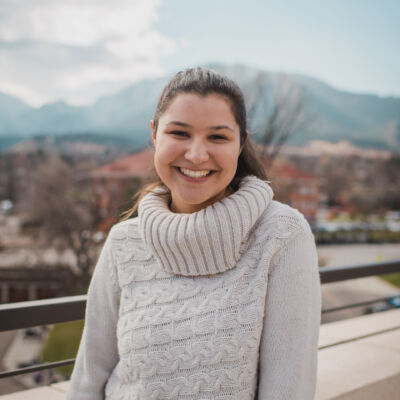
Tayler Shaw is a senior majoring in journalism and Spanish for the professions and minoring in anthropology and leadership studies. She is from Littleton, Colorado. Her interests include explanatory and solutions journalism on topics ranging from education, culture and community-based issues.

Marc Lacrampe graduated from CU Boulder in May 2020 with a B.A. in Environmental Studies. He is currently located in Boulder, Colorado and is making it through this pandemic by hiking, biking, camping, playing tennis and (hopefully soon) snowboarding!
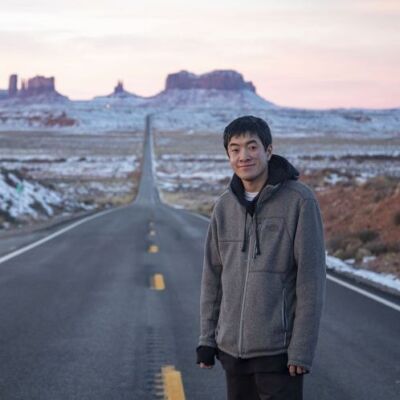
Kevin Wu is currently a junior pursuing major’s in Cinema Studies and Media Production with also a minor in Business. He is from Superior, Colorado and has interests in film, photography, hiking and watching Marvel movies/tv shows. Kevin also serves as a student ambassador for the Office of Admissions.

Georgia Worrell is a junior at CU Boulder double majoring in Spanish and journalism. She is originally from Coeur d’Alene, Idaho but now calls Seattle, Washington “home.” She enjoys reading, traveling, spending time with friends and family and loves coffee!

Sierra George is a sophomore majoring in strategic communications with an emphasis in advertising and a minor in creative technology and design. She is from Broomfield, Colorado. In her free time, she enjoys doing film photography, dance and hiking.

Grace Naber in a junior studying Public Relations with a Business minor and a certificate in International Media. She is from Boulder, Colorado and loves to cook plant-based food, travel, ski, trail-run and do yoga.

